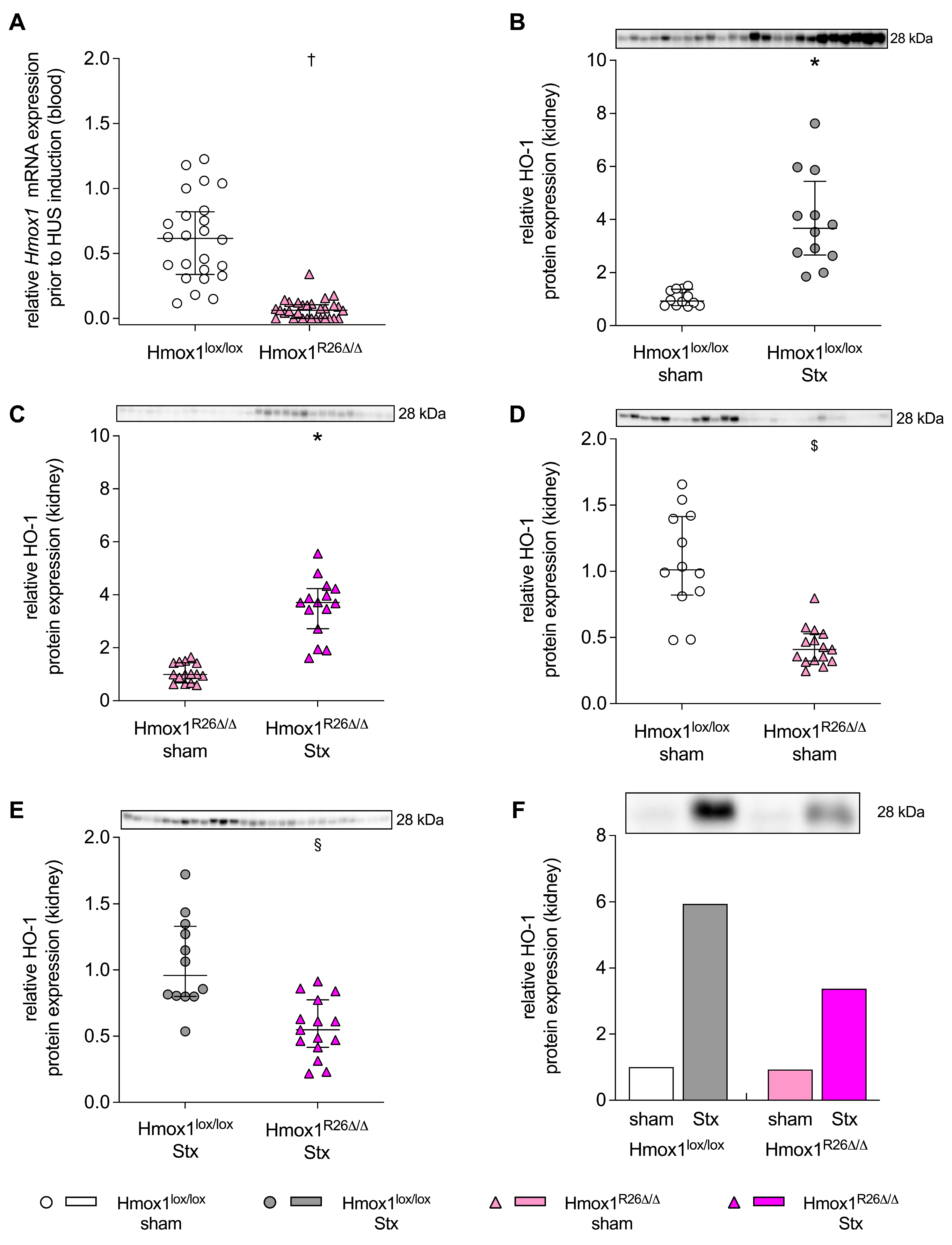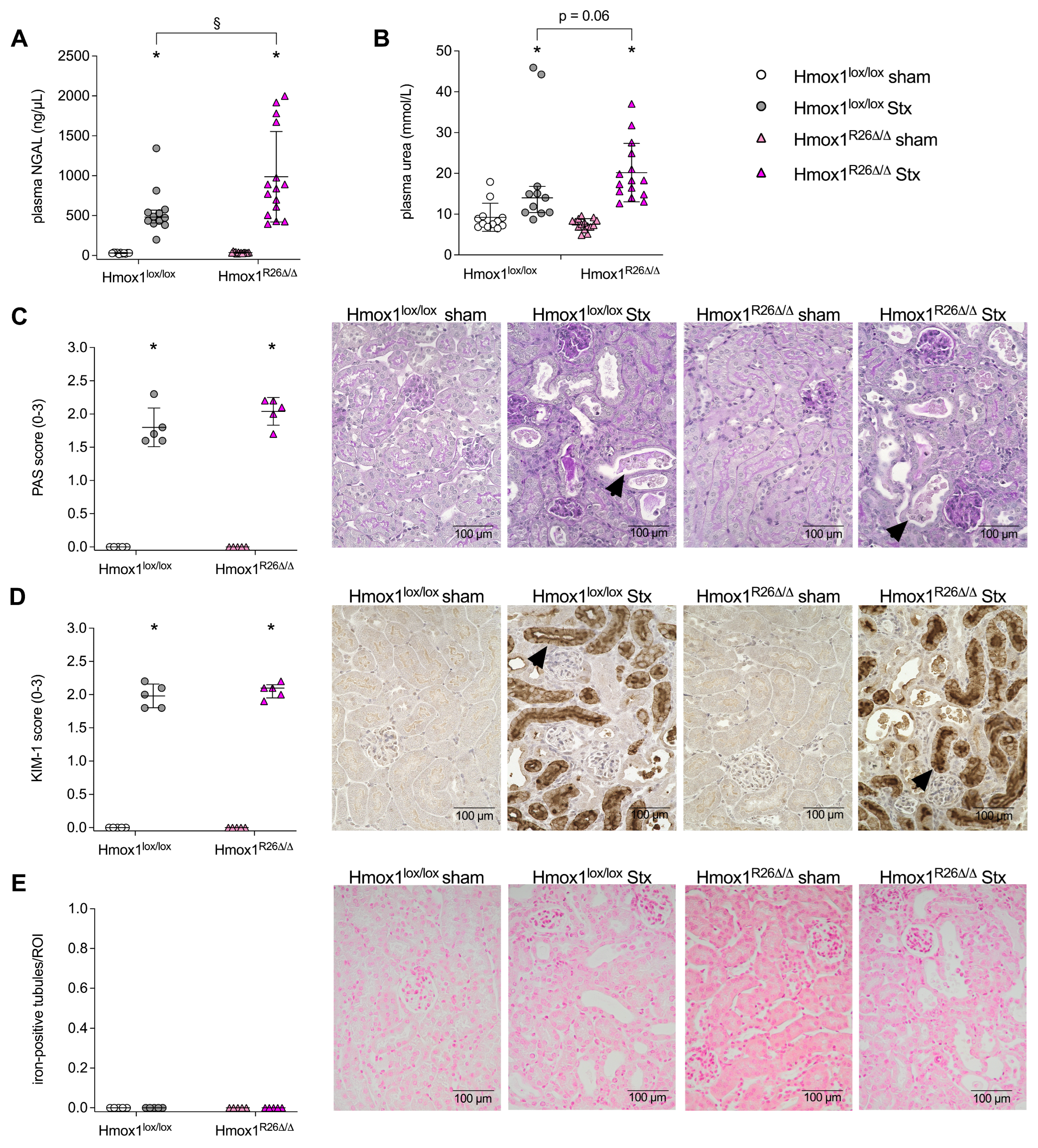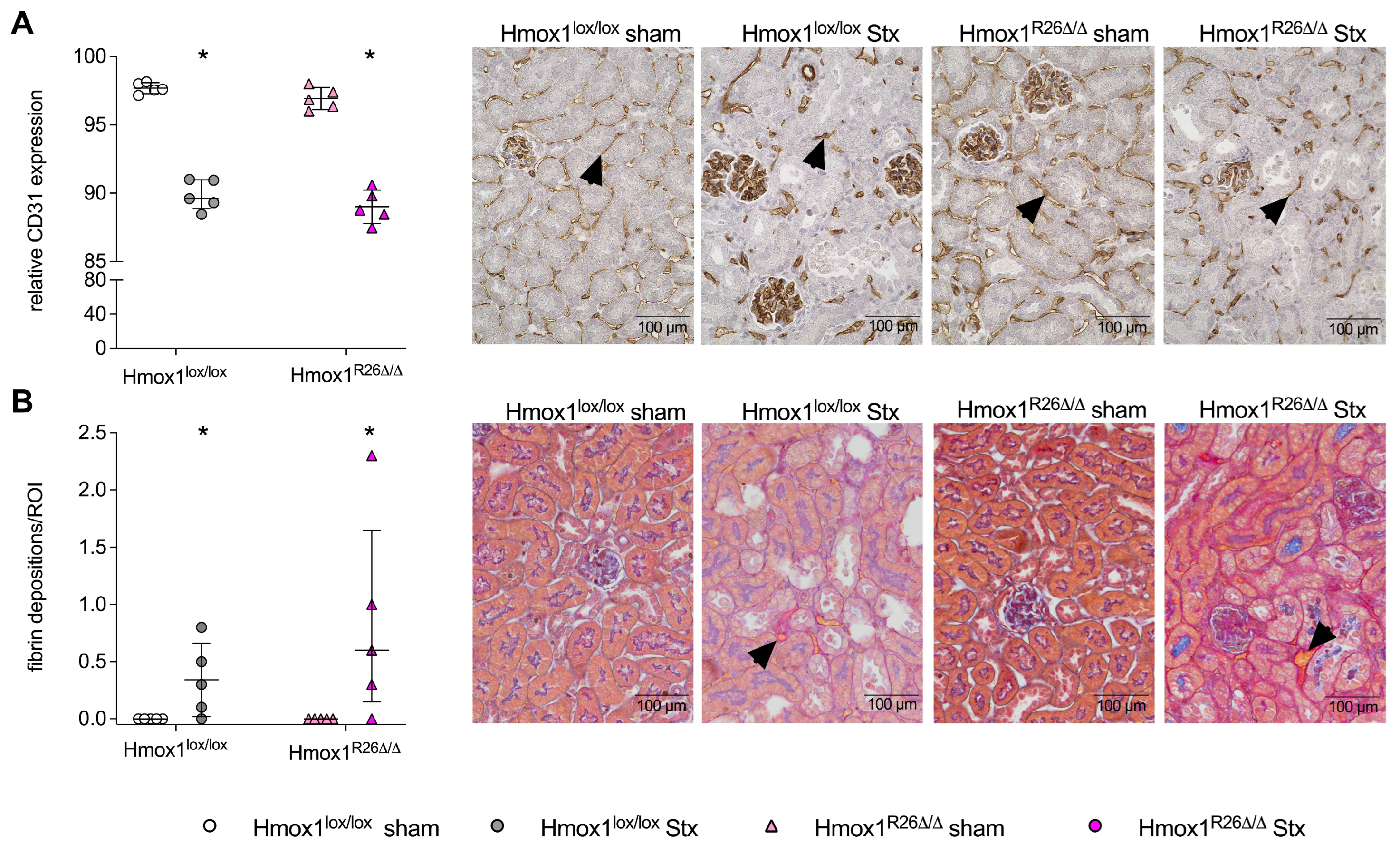Reduction in Renal Heme Oxygenase-1 Is Associated with an Aggravation of Kidney Injury in Shiga Toxin-Induced Murine Hemolytic-Uremic Syndrome
Abstract
:1. Introduction
2. Results
2.1. Hmox1 Expression in the Blood Prior to HUS Induction and Renal HO-1 Levels in Hmox1lox/lox and Hmox1R26Δ/Δ Mice with HUS
2.2. Effect of Hmox1 Deficiency on Clinical Presentation of Mice with HUS
2.3. Effect of Hmox1 Deficiency on Kidney Injury in Mice with HUS
2.4. Effect of Hmox1 Deficiency on Renal Thrombotic Microangiopathy in Mice with HUS
3. Discussion
4. Conclusions
5. Materials and Methods
5.1. Mice with Tamoxifen-Induced Hmox1 Gene Deletion and Corresponding Control Mice
5.2. Stx2 Purification
5.3. Hmox1 Gene Expression and Analysis
5.4. Experimental HUS
5.5. Western Blot Analysis
5.6. Blood and Plasma Sample Analysis
5.7. Tissue Preparation and Histological and Immunohistochemical Analysis
5.8. Statistics
Supplementary Materials
Author Contributions
Funding
Institutional Review Board Statement
Informed Consent Statement
Data Availability Statement
Conflicts of Interest
References
- Fruth, A.; Lang, C.; Größl, T.; Garn, T.; Flieger, A. Genomic surveillance of STEC/EHEC infections in Germany 2020 to 2022 permits insight into virulence gene profiles and novel O-antigen gene clusters. Int. J. Med. Microbiol. 2024, 314, 151610. [Google Scholar] [CrossRef] [PubMed]
- Rivas, M.; Pichel, M.; Colonna, M.; Casanello, A.L.; Alconcher, L.F.; Galavotti, J.; Principi, I.; Araujo, S.P.; Ramírez, F.B.; González, G.; et al. Surveillance of Shiga toxin-producing Escherichia coli associated bloody diarrhea in Argentina. Rev. Argent. Microbiol. 2023, 55, 345–354. [Google Scholar] [CrossRef] [PubMed]
- Seliga-Gąsior, D.; Sokól-Leszczyñska, B.; Krzysztoñ-Russjan, J.; Wierzbicka, D.; Stępieñ-Hołubczat, K.; Lewandowska, P.; Frankiewicz, E.; Cacko, A.; Leszczyñska, B.; Demkow, U.; et al. Epidemiological Characteristics of Shiga Toxin-Producing Escherichia coli Responsible for Infections in the Polish Pediatric Population. Pol. J. Microbiol. 2024, 73, 177–187. [Google Scholar] [CrossRef] [PubMed]
- Fakhouri, F.; Zuber, J.; Frémeaux-Bacchi, V.; Loirat, C. Haemolytic uraemic syndrome. Lancet 2017, 390, 681–696. [Google Scholar] [CrossRef] [PubMed]
- Ruggenenti, P.; Noris, M.; Remuzzi, G. Thrombotic microangiopathy, hemolytic uremic syndrome, and thrombotic thrombocytopenic purpura. Kidney Int. 2001, 60, 831–846. [Google Scholar] [CrossRef]
- Liu, Y.; Thaker, H.; Wang, C.; Xu, Z.; Dong, M. Diagnosis and Treatment for Shiga Toxin-Producing Escherichia coli Associated Hemolytic Uremic Syndrome. Toxins 2022, 15, 10. [Google Scholar] [CrossRef]
- Alconcher, L.F.; Lucarelli, L.I.; Bronfen, S. Long-term kidney outcomes in non-dialyzed children with Shiga-toxin Escherichia coli associated hemolytic uremic syndrome. Pediatr. Nephrol. 2023, 38, 2131–2136. [Google Scholar] [CrossRef]
- Larsen, R.; Gozzelino, R.; Jeney, V.; Tokaji, L.; Bozza, F.A.; Japiassú, A.M.; Bonaparte, D.; Cavalcante, M.M.; Chora, A.; Ferreira, A.; et al. A central role for free heme in the pathogenesis of severe sepsis. Sci. Transl. Med. 2010, 2, 51ra71. [Google Scholar] [CrossRef]
- Merle, N.S.; Grunenwald, A.; Rajaratnam, H.; Gnemmi, V.; Frimat, M.; Figueres, M.L.; Knockaert, S.; Bouzekri, S.; Charue, D.; Noe, R.; et al. Intravascular hemolysis activates complement via cell-free heme and heme-loaded microvesicles. JCI Insight 2018, 3, e96910. [Google Scholar] [CrossRef]
- Elphinstone, R.E.; Conroy, A.L.; Hawkes, M.; Hermann, L.; Namasopo, S.; Warren, H.S.; John, C.C.; Liles, W.C.; Kain, K.C. Alterations in Systemic Extracellular Heme and Hemopexin Are Associated With Adverse Clinical Outcomes in Ugandan Children With Severe Malaria. J. Infect. Dis. 2016, 214, 1268–1275. [Google Scholar] [CrossRef]
- Liu, Y.; Jing, F.; Yi, W.; Mendelson, A.; Shi, P.; Walsh, R.; Friedman, D.F.; Minniti, C.; Manwani, D.; Chou, S.T.; et al. HO-1(hi) patrolling monocytes protect against vaso-occlusion in sickle cell disease. Blood 2018, 131, 1600–1610. [Google Scholar] [CrossRef] [PubMed]
- Belcher, J.D.; Mahaseth, H.; Welch, T.E.; Otterbein, L.E.; Hebbel, R.P.; Vercellotti, G.M. Heme oxygenase-1 is a modulator of inflammation and vaso-occlusion in transgenic sickle mice. J. Clin. Investig. 2006, 116, 808–816. [Google Scholar] [CrossRef] [PubMed]
- Vissa, M.; Larkin, S.K.; Vichinsky, E.P.; Kuypers, F.A.; Soupene, E. Assessment of total and unbound cell-free heme in plasma of patients with sickle cell disease. Exp. Biol. Med. 2023, 248, 897–907. [Google Scholar] [CrossRef]
- Gbotosho, O.T.; Kapetanaki, M.G.; Kato, G.J. The Worst Things in Life are Free: The Role of Free Heme in Sickle Cell Disease. Front. Immunol. 2020, 11, 561917. [Google Scholar] [CrossRef]
- Campbell, N.K.; Fitzgerald, H.K.; Dunne, A. Regulation of inflammation by the antioxidant haem oxygenase 1. Nat. Rev. Immunol. 2021, 21, 411–425. [Google Scholar] [CrossRef]
- Ryter, S.W.; Alam, J.; Choi, A.M. Heme oxygenase-1/carbon monoxide: From basic science to therapeutic applications. Physiol. Rev. 2006, 86, 583–650. [Google Scholar] [CrossRef]
- Gozzelino, R.; Jeney, V.; Soares, M.P. Mechanisms of cell protection by heme oxygenase-1. Annu. Rev. Pharmacol. Toxicol. 2010, 50, 323–354. [Google Scholar] [CrossRef]
- Ryter, S.W. Heme Oxygenase-1: An Anti-Inflammatory Effector in Cardiovascular, Lung, and Related Metabolic Disorders. Antioxidants 2022, 11, 555. [Google Scholar] [CrossRef]
- Dutra, F.F.; Bozza, M.T. Heme on innate immunity and inflammation. Front. Pharmacol. 2014, 5, 115. [Google Scholar] [CrossRef]
- Vinchi, F.; Costa da Silva, M.; Ingoglia, G.; Petrillo, S.; Brinkman, N.; Zuercher, A.; Cerwenka, A.; Tolosano, E.; Muckenthaler, M.U. Hemopexin therapy reverts heme-induced proinflammatory phenotypic switching of macrophages in a mouse model of sickle cell disease. Blood 2016, 127, 473–486. [Google Scholar] [CrossRef]
- Seixas, E.; Gozzelino, R.; Chora, A.; Ferreira, A.; Silva, G.; Larsen, R.; Rebelo, S.; Penido, C.; Smith, N.R.; Coutinho, A.; et al. Heme oxygenase-1 affords protection against noncerebral forms of severe malaria. Proc. Natl. Acad. Sci. USA 2009, 106, 15837–15842. [Google Scholar] [CrossRef] [PubMed]
- de Azevedo-Quintanilha, I.G.; Medeiros-de-Moraes, I.M.; Ferreira, A.C.; Reis, P.A.; Vieira-de-Abreu, A.; Campbell, R.A.; Weyrich, A.S.; Bozza, P.T.; Zimmerman, G.A.; Castro-Faria-Neto, H.C. Haem oxygenase protects against thrombocytopaenia and malaria-associated lung injury. Malar. J. 2020, 19, 234. [Google Scholar] [CrossRef] [PubMed]
- Pirschel, W.; Mestekemper, A.N.; Wissuwa, B.; Krieg, N.; Kröller, S.; Daniel, C.; Gunzer, F.; Tolosano, E.; Bauer, M.; Amann, K.; et al. Divergent roles of haptoglobin and hemopexin deficiency for disease progression of Shiga-toxin-induced hemolytic-uremic syndrome in mice. Kidney Int. 2022, 101, 1171–1185. [Google Scholar] [CrossRef] [PubMed]
- Wijnsma, K.L.; Veissi, S.T.; de Wijs, S.; van der Velden, T.; Volokhina, E.B.; Wagener, F.; van de Kar, N.; van den Heuvel, L.P. Heme as Possible Contributing Factor in the Evolvement of Shiga-Toxin Escherichia coli Induced Hemolytic-Uremic Syndrome. Front. Immunol. 2020, 11, 547406. [Google Scholar] [CrossRef] [PubMed]
- Lusco, M.A.; Fogo, A.B.; Najafian, B.; Alpers, C.E. AJKD Atlas of Renal Pathology: Thrombotic Microangiopathy. Am. J. Kidney Dis. 2016, 68, e33–e34. [Google Scholar] [CrossRef]
- Grinshtein, N.; Bamm, V.V.; Tsemakhovich, V.A.; Shaklai, N. Mechanism of low-density lipoprotein oxidation by hemoglobin-derived iron. Biochemistry 2003, 42, 6977–6985. [Google Scholar] [CrossRef]
- Graça-Souza, A.V.; Arruda, M.A.; de Freitas, M.S.; Barja-Fidalgo, C.; Oliveira, P.L. Neutrophil activation by heme: Implications for inflammatory processes. Blood 2002, 99, 4160–4165. [Google Scholar] [CrossRef]
- Wagener, F.A.; Eggert, A.; Boerman, O.C.; Oyen, W.J.; Verhofstad, A.; Abraham, N.G.; Adema, G.; van Kooyk, Y.; de Witte, T.; Figdor, C.G. Heme is a potent inducer of inflammation in mice and is counteracted by heme oxygenase. Blood 2001, 98, 1802–1811. [Google Scholar] [CrossRef]
- Kaide, J.I.; Zhang, F.; Wei, Y.; Jiang, H.; Yu, C.; Wang, W.H.; Balazy, M.; Abraham, N.G.; Nasjletti, A. Carbon monoxide of vascular origin attenuates the sensitivity of renal arterial vessels to vasoconstrictors. J. Clin. Investig. 2001, 107, 1163–1171. [Google Scholar] [CrossRef]
- Brouard, S.; Otterbein, L.E.; Anrather, J.; Tobiasch, E.; Bach, F.H.; Choi, A.M.; Soares, M.P. Carbon monoxide generated by heme oxygenase 1 suppresses endothelial cell apoptosis. J. Exp. Med. 2000, 192, 1015–1026. [Google Scholar] [CrossRef]
- Ryter, S.W. Significance of Heme and Heme Degradation in the Pathogenesis of Acute Lung and Inflammatory Disorders. Int. J. Mol. Sci. 2021, 22, 5509. [Google Scholar] [CrossRef] [PubMed]
- Sedlak, T.W.; Saleh, M.; Higginson, D.S.; Paul, B.D.; Juluri, K.R.; Snyder, S.H. Bilirubin and glutathione have complementary antioxidant and cytoprotective roles. Proc. Natl. Acad. Sci. USA 2009, 106, 5171–5176. [Google Scholar] [CrossRef] [PubMed]
- Manikanta; NaveenKumar, S.K.; Thushara, R.M.; Hemshekhar, M.; Sumedini, M.L.; Sunitha, K.; Kemparaju, K.; Girish, K.S. Counteraction of unconjugated bilirubin against heme-induced toxicity in platelets. Thromb. Res. 2024, 244, 109199. [Google Scholar] [CrossRef] [PubMed]
- Huang, S.S.; Ding, Y.; Yi, X.N.; Mao, H.Y.; Xie, Z.Y.; Shen, X.K.; Lu, Y.; Yan, J.; Wang, Y.W.; Yang, Z.X. Exploring the inverse relationship between serum total bilirubin and systemic immune-inflammation index: Insights from NHANES data (2009–2018). Eur. J. Med. Res. 2024, 29, 362. [Google Scholar] [CrossRef]
- Bitzan, M.; Bickford, B.B.; Foster, G.H. Verotoxin (shiga toxin) sensitizes renal epithelial cells to increased heme toxicity: Possible implications for the hemolytic uremic syndrome. J. Am. Soc. Nephrol. 2004, 15, 2334–2343. [Google Scholar] [CrossRef]
- Vareille, M.; Rannou, F.; Thélier, N.; Glasser, A.L.; de Sablet, T.; Martin, C.; Gobert, A.P. Heme oxygenase-1 is a critical regulator of nitric oxide production in enterohemorrhagic Escherichia coli-infected human enterocytes. J. Immunol. 2008, 180, 5720–5726. [Google Scholar] [CrossRef]
- Sauter, K.A.; Melton-Celsa, A.R.; Larkin, K.; Troxell, M.L.; O’Brien, A.D.; Magun, B.E. Mouse model of hemolytic-uremic syndrome caused by endotoxin-free Shiga toxin 2 (Stx2) and protection from lethal outcome by anti-Stx2 antibody. Infect. Immun. 2008, 76, 4469–4478. [Google Scholar] [CrossRef]
- Dennhardt, S.; Pirschel, W.; Wissuwa, B.; Daniel, C.; Gunzer, F.; Lindig, S.; Medyukhina, A.; Kiehntopf, M.; Rudolph, W.W.; Zipfel, P.F.; et al. Modeling Hemolytic-Uremic Syndrome: In-Depth Characterization of Distinct Murine Models Reflecting Different Features of Human Disease. Front. Immunol. 2018, 9, 1459. [Google Scholar] [CrossRef]
- Kumar, R.; Mao, Y.; Patial, S.; Saini, Y. Induction of whole-body gene deletion via R26-regulated tamoxifen-inducible Cre recombinase activity. Front. Pharmacol. 2022, 13, 1018798. [Google Scholar] [CrossRef]
- Ilchuk, L.A.; Stavskaya, N.I.; Varlamova, E.A.; Khamidullina, A.I.; Tatarskiy, V.V.; Mogila, V.A.; Kolbutova, K.B.; Bogdan, S.A.; Sheremetov, A.M.; Baulin, A.N.; et al. Limitations of Tamoxifen Application for In Vivo Genome Editing Using Cre/ER(T2) System. Int. J. Mol. Sci. 2022, 23, 14077. [Google Scholar] [CrossRef]
- Bolisetty, S.; Traylor, A.; Joseph, R.; Zarjou, A.; Agarwal, A. Proximal tubule-targeted heme oxygenase-1 in cisplatin-induced acute kidney injury. Am. J. Physiol. Renal Physiol. 2016, 310, F385–F394. [Google Scholar] [CrossRef] [PubMed]
- Zelenay, S.; Chora, A.; Soares, M.P.; Demengeot, J. Heme oxygenase-1 is not required for mouse regulatory T cell development and function. Int. Immunol. 2006, 19, 11–18. [Google Scholar] [CrossRef] [PubMed]
- Yoshida, T.; Maulik, N.; Ho, Y.S.; Alam, J.; Das, D.K. H(mox-1) constitutes an adaptive response to effect antioxidant cardioprotection: A study with transgenic mice heterozygous for targeted disruption of the Heme oxygenase-1 gene. Circulation 2001, 103, 1695–1701. [Google Scholar] [CrossRef] [PubMed]
- Rana, M.; Choubey, P.; Nandi, G.; Jain, S.; Bajaj, D.; Sharma, S.; Basu-Modak, S. Expression of angiogenic factors in the placenta of heme oxygenase-1 deficient mouse embryo. Reprod. Biol. 2023, 23, 100822. [Google Scholar] [CrossRef]
- Meyer, N.; Langwisch, S.; Scharm, M.; Zenclussen, A.C. Using ultrasound to define the time point of intrauterine growth retardation in a mouse model of heme oxygenase-1 deficiency†. Biol. Reprod. 2020, 103, 126–134. [Google Scholar] [CrossRef]
- Marakala, V. Neutrophil gelatinase-associated lipocalin (NGAL) in kidney injury—A systematic review. Clin. Chim. Acta 2022, 536, 135–141. [Google Scholar] [CrossRef]
- Pan, H.C.; Yang, S.Y.; Chiou, T.T.; Shiao, C.C.; Wu, C.H.; Huang, C.T.; Wang, T.J.; Chen, J.Y.; Liao, H.W.; Chen, S.Y.; et al. Comparative accuracy of biomarkers for the prediction of hospital-acquired acute kidney injury: A systematic review and meta-analysis. Crit. Care 2022, 26, 349. [Google Scholar] [CrossRef]
- Haase-Fielitz, A.; Bellomo, R.; Devarajan, P.; Story, D.; Matalanis, G.; Dragun, D.; Haase, M. Novel and conventional serum biomarkers predicting acute kidney injury in adult cardiac surgery--a prospective cohort study. Crit. Care Med. 2009, 37, 553–560. [Google Scholar] [CrossRef]
- Xu, M.J.; Feng, D.; Wu, H.; Wang, H.; Chan, Y.; Kolls, J.; Borregaard, N.; Porse, B.; Berger, T.; Mak, T.W.; et al. Liver is the major source of elevated serum lipocalin-2 levels after bacterial infection or partial hepatectomy: A critical role for IL-6/STAT3. Hepatology 2015, 61, 692–702. [Google Scholar] [CrossRef]
- Cowland, J.B.; Sørensen, O.E.; Sehested, M.; Borregaard, N. Neutrophil gelatinase-associated lipocalin is up-regulated in human epithelial cells by IL-1 beta, but not by TNF-alpha. J. Immunol. 2003, 171, 6630–6639. [Google Scholar] [CrossRef]
- Yoo, D.Y.; Ko, S.H.; Jung, J.; Kim, Y.J.; Kim, J.S.; Kim, J.M. Bacteroides fragilis enterotoxin upregulates lipocalin-2 expression in intestinal epithelial cells. Lab. Investig. 2013, 93, 384–396. [Google Scholar] [CrossRef] [PubMed]
- Pamplona, A.; Ferreira, A.; Balla, J.; Jeney, V.; Balla, G.; Epiphanio, S.; Chora, A.; Rodrigues, C.D.; Gregoire, I.P.; Cunha-Rodrigues, M.; et al. Heme oxygenase-1 and carbon monoxide suppress the pathogenesis of experimental cerebral malaria. Nat. Med. 2007, 13, 703–710. [Google Scholar] [CrossRef] [PubMed]
- Łoboda, A.; Mucha, O.; Podkalicka, P.; Sobczak, M.; Miksza-Cybulska, A.; Kaczara, P.; Jozkowicz, A.; Dulak, J. Kidney injury by cyclosporine A is aggravated in heme oxygenase-1 deficient mice and involves regulation of microRNAs. Acta Biochim. Pol. 2018, 65, 613–620. [Google Scholar] [CrossRef] [PubMed]
- Yachie, A.; Niida, Y.; Wada, T.; Igarashi, N.; Kaneda, H.; Toma, T.; Ohta, K.; Kasahara, Y.; Koizumi, S. Oxidative stress causes enhanced endothelial cell injury in human heme oxygenase-1 deficiency. J. Clin. Investig. 1999, 103, 129–135. [Google Scholar] [CrossRef] [PubMed]
- Tahghighi, F.; Parvaneh, N.; Ziaee, V. Post-mortem Diagnosis of Heme Oxygenase-1 Deficiency by Whole Exome Sequencing in an Iranian Child. Int. J. Mol. Cell Med. 2019, 8, 300–307. [Google Scholar] [CrossRef]
- Chau, A.S.; Cole, B.L.; Debley, J.S.; Nanda, K.; Rosen, A.B.I.; Bamshad, M.J.; Nickerson, D.A.; Torgerson, T.R.; Allenspach, E.J. Heme oxygenase-1 deficiency presenting with interstitial lung disease and hemophagocytic flares. Pediatr. Rheumatol. Online J. 2020, 18, 80. [Google Scholar] [CrossRef]
- Poss, K.D.; Tonegawa, S. Heme oxygenase 1 is required for mammalian iron reutilization. Proc. Natl. Acad. Sci. USA 1997, 94, 10919–10924. [Google Scholar] [CrossRef]
- Bednarz, A.; Lipiński, P.; Starzyński, R.R.; Tomczyk, M.; Kraszewska, I.; Herman, S.; Kowalski, K.; Gruca, E.; Jończy, A.; Mazgaj, R.; et al. Exacerbation of Neonatal Hemolysis and Impaired Renal Iron Handling in Heme Oxygenase 1-Deficient Mice. Int. J. Mol. Sci. 2020, 21, 7754. [Google Scholar] [CrossRef]
- Kopacz, A.; Klóska, D.; Cysewski, D.; Kraszewska, I.; Przepiórska, K.; Lenartowicz, M.; Łoboda, A.; Grochot-Przęczek, A.; Nowak, W.; Józkowicz, A.; et al. Co-administration of angiotensin II and simvastatin triggers kidney injury upon heme oxygenase-1 deficiency. Free Radic. Biol. Med. 2023, 205, 188–201. [Google Scholar] [CrossRef]
- Fagoonee, S.; Gburek, J.; Hirsch, E.; Marro, S.; Moestrup, S.K.; Laurberg, J.M.; Christensen, E.I.; Silengo, L.; Altruda, F.; Tolosano, E. Plasma protein haptoglobin modulates renal iron loading. Am. J. Pathol. 2005, 166, 973–983. [Google Scholar] [CrossRef]
- Mayer, C.L.; Leibowitz, C.S.; Kurosawa, S.; Stearns-Kurosawa, D.J. Shiga toxins and the pathophysiology of hemolytic uremic syndrome in humans and animals. Toxins 2012, 4, 1261–1287. [Google Scholar] [CrossRef] [PubMed]
- DeSouza-Vieira, T.; Iniguez, E.; Serafim, T.D.; de Castro, W.; Karmakar, S.; Disotuar, M.M.; Cecilio, P.; Lacsina, J.R.; Meneses, C.; Nagata, B.M.; et al. Heme Oxygenase-1 Induction by Blood-Feeding Arthropods Controls Skin Inflammation and Promotes Disease Tolerance. Cell Rep. 2020, 33, 108317. [Google Scholar] [CrossRef] [PubMed]
- Faul, F.; Erdfelder, E.; Lang, A.G.; Buchner, A. G*Power 3: A flexible statistical power analysis program for the social, behavioral, and biomedical sciences. Behav. Res. Methods 2007, 39, 175–191. [Google Scholar] [CrossRef]
- Griffin, P.M.; Ostroff, S.M.; Tauxe, R.V.; Greene, K.D.; Wells, J.G.; Lewis, J.H.; Blake, P.A. Illnesses associated with Escherichia coli O157:H7 infections. A broad clinical spectrum. Ann. Intern. Med. 1988, 109, 705–712. [Google Scholar] [CrossRef]
- Livak, K.J.; Schmittgen, T.D. Analysis of relative gene expression data using real-time quantitative PCR and the 2(-Delta Delta C(T)) Method. Methods 2001, 25, 402–408. [Google Scholar] [CrossRef]
- Gilda, J.E.; Gomes, A.V. Stain-Free total protein staining is a superior loading control to β-actin for Western blots. Anal. Biochem. 2013, 440, 186–188. [Google Scholar] [CrossRef]
- R Core Team. R: A Language and Environment for Statistical Computing; R Foundation for Statistical Computing: Vienna, Austria, 2023. [Google Scholar]




Disclaimer/Publisher’s Note: The statements, opinions and data contained in all publications are solely those of the individual author(s) and contributor(s) and not of MDPI and/or the editor(s). MDPI and/or the editor(s) disclaim responsibility for any injury to people or property resulting from any ideas, methods, instructions or products referred to in the content. |
© 2024 by the authors. Licensee MDPI, Basel, Switzerland. This article is an open access article distributed under the terms and conditions of the Creative Commons Attribution (CC BY) license (https://creativecommons.org/licenses/by/4.0/).
Share and Cite
Mestekemper, A.N.; Pirschel, W.; Krieg, N.; Paulmann, M.K.; Daniel, C.; Amann, K.; Coldewey, S.M. Reduction in Renal Heme Oxygenase-1 Is Associated with an Aggravation of Kidney Injury in Shiga Toxin-Induced Murine Hemolytic-Uremic Syndrome. Toxins 2024, 16, 543. https://doi.org/10.3390/toxins16120543
Mestekemper AN, Pirschel W, Krieg N, Paulmann MK, Daniel C, Amann K, Coldewey SM. Reduction in Renal Heme Oxygenase-1 Is Associated with an Aggravation of Kidney Injury in Shiga Toxin-Induced Murine Hemolytic-Uremic Syndrome. Toxins. 2024; 16(12):543. https://doi.org/10.3390/toxins16120543
Chicago/Turabian StyleMestekemper, Antonio N., Wiebke Pirschel, Nadine Krieg, Maria K. Paulmann, Christoph Daniel, Kerstin Amann, and Sina M. Coldewey. 2024. "Reduction in Renal Heme Oxygenase-1 Is Associated with an Aggravation of Kidney Injury in Shiga Toxin-Induced Murine Hemolytic-Uremic Syndrome" Toxins 16, no. 12: 543. https://doi.org/10.3390/toxins16120543
APA StyleMestekemper, A. N., Pirschel, W., Krieg, N., Paulmann, M. K., Daniel, C., Amann, K., & Coldewey, S. M. (2024). Reduction in Renal Heme Oxygenase-1 Is Associated with an Aggravation of Kidney Injury in Shiga Toxin-Induced Murine Hemolytic-Uremic Syndrome. Toxins, 16(12), 543. https://doi.org/10.3390/toxins16120543




